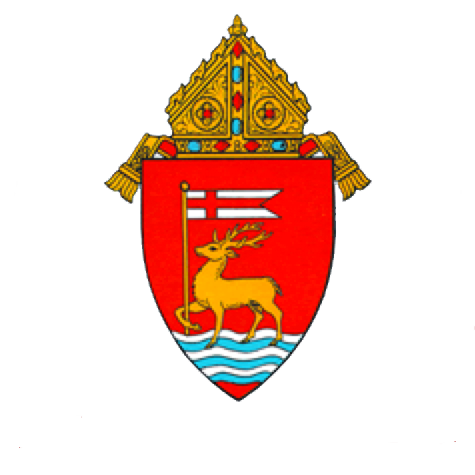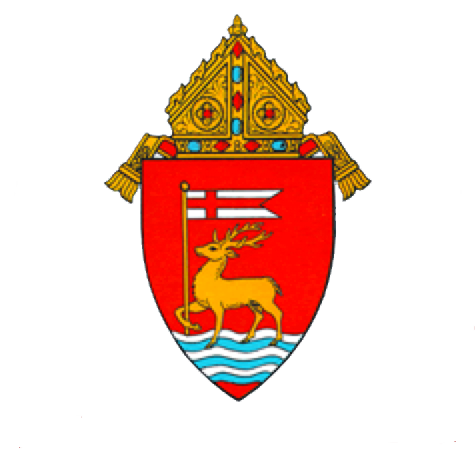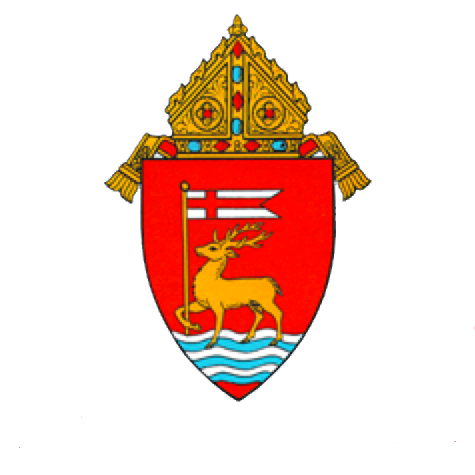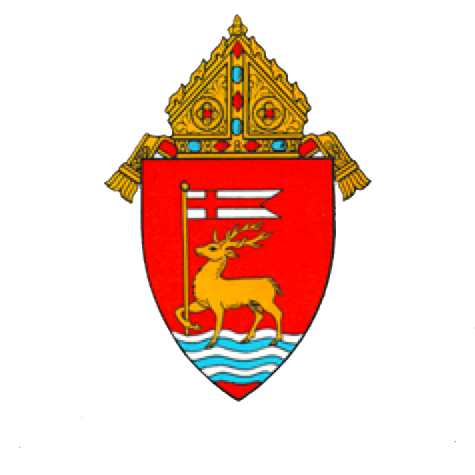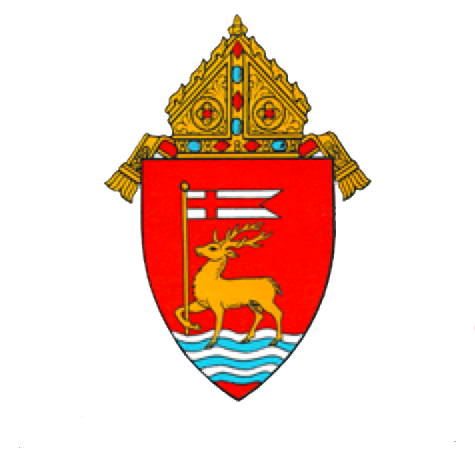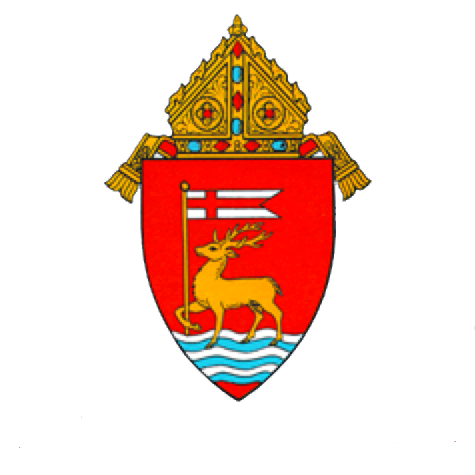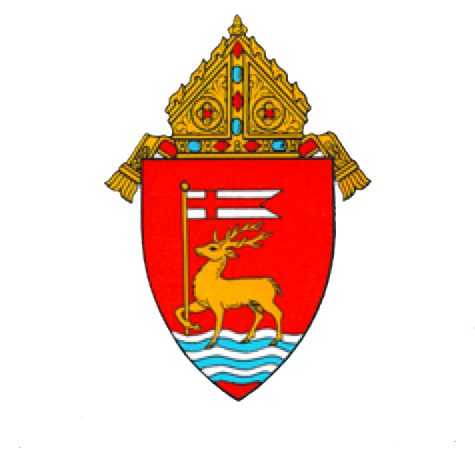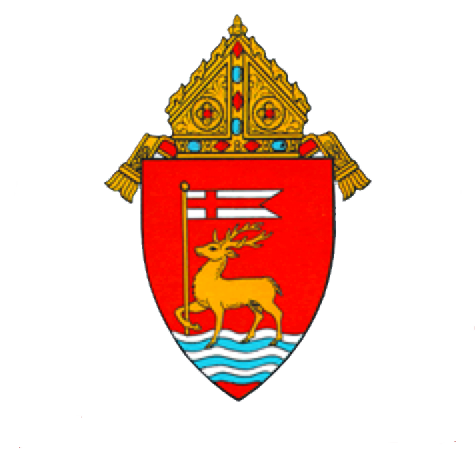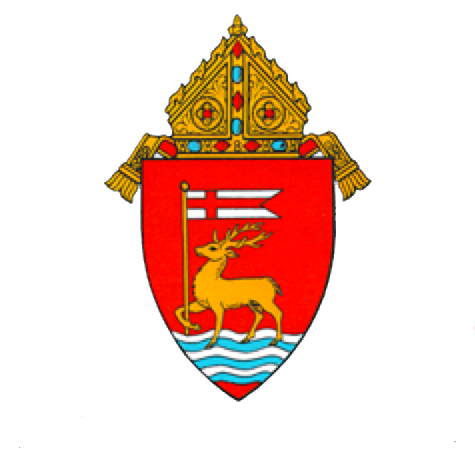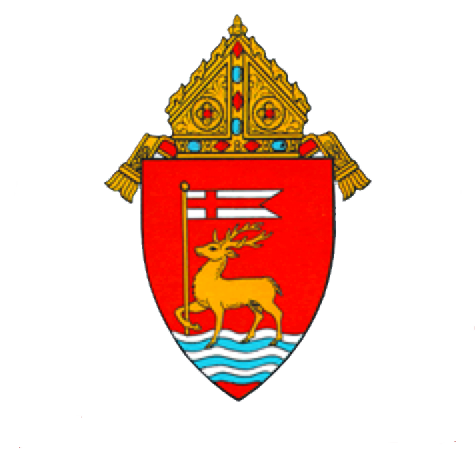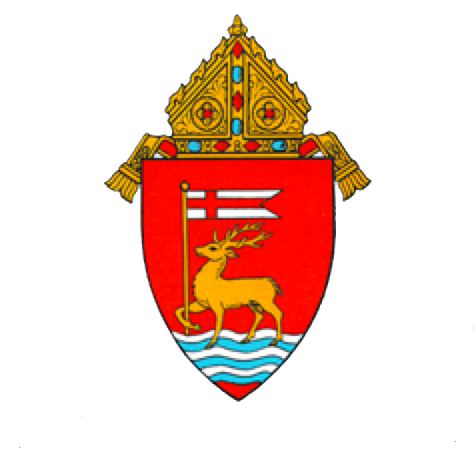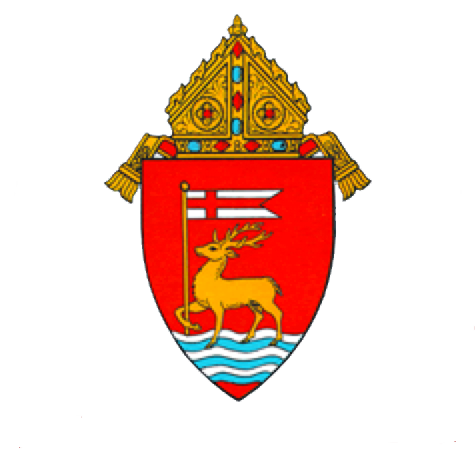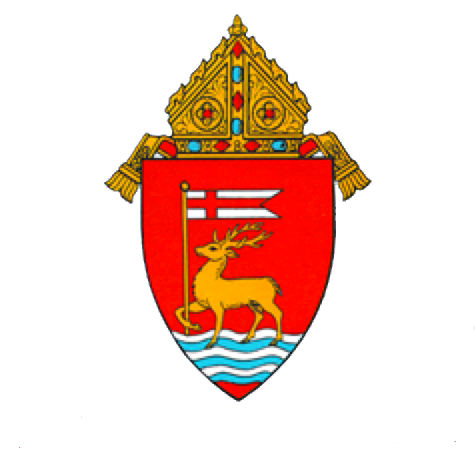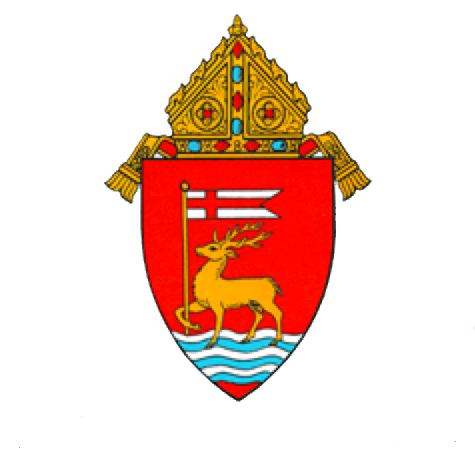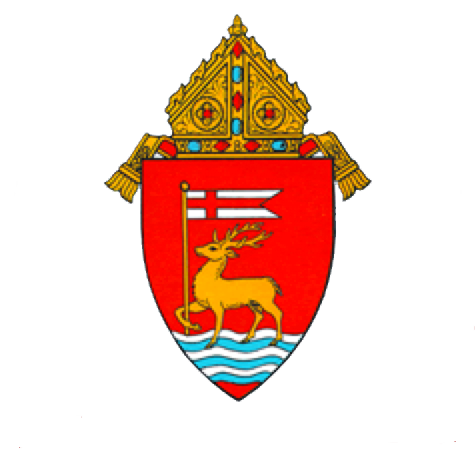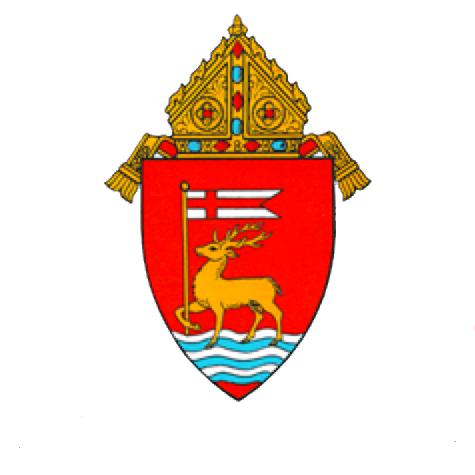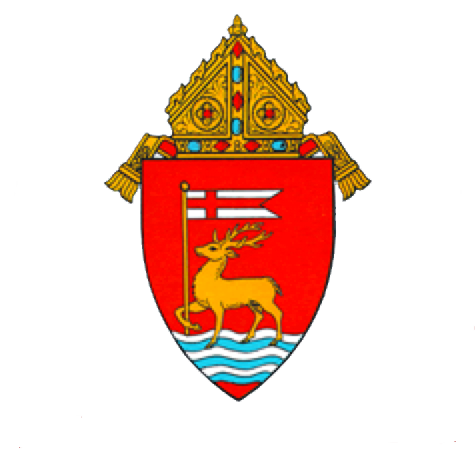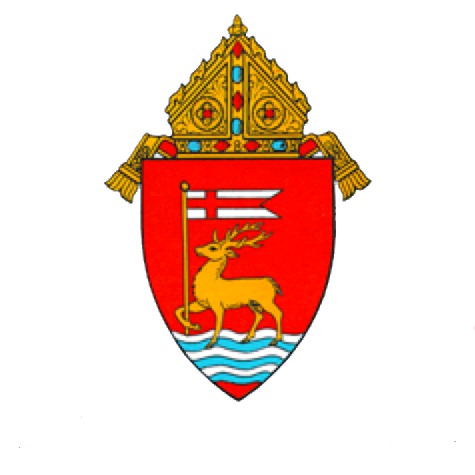Cathedral of Saint Joseph, Hartford
Blessed Sacrament Chapel Windows
The nine windows are of thick glass set in cement and chipped with special tools to give a brilliant, faceted appearance like that of a cut jewel. They are the work of Pierre Millous. The subjects, all Gospel parables or incidents, are as follows, from left to right: Birds of the air, lilies of the field; The Savior feeds four thousand; The Prodigal Son; The Savior bids the children come to Him; The Good Samaritan, The Savior heals the woman with issue of blood; The neighbor who begs bread at midnight (prayer will always be heard); The Savior weeps over Jerusalem; and The shepherd finds the lost sheep.
The baldachin
The form is that of a tripod, symbolic of the Holy Trinity, with a crown binding that uprights together. Above the crown, three curving members merge in a finial, the top of which is 44’ above the predella. The three uprights carry a sculpture of an archangel: Gabriel, Raphael, and Uriel. The finial is topped by a sculpture of the Archangel Michael, holding a golden thurible. These four figures were designed by Gleb Derujinsky. The material of the baldachin is cast and sheet aluminum. On the uprights are crosses of anodized aluminum. On the crown, finial, and thurible of the Archangel Michael, there is gold leafing. The soffit, or ceiling, of the baldachin features the figure of a dove, symbolic of the Holy Spirit. On the soffit, as on the crown, there is some red enamelling. By rods projecting from the rear upright of the baldachin there is held above the altar a large crucifix of walnut, with ebonized inlay and bound in aluminum. The corpus, of hard pine, was carved by Alcide Ticó.
The Savior's Triumph
1st Window (right) - (lower section) Magdalene at the empty tomb. 1st Window (right) - (upper section) Peter and John at the empty tomb. 2nd Window (center) - The Risen Savior. 3rd Window (left) - The apostles, in the upper room on the first Easter night, behold the Risen Savior.
The Archbishop's throne
The throne stands on the topmost of three steps of Botticino marble. The archbishop's chair is of American walnut, richly carved and with an inlay of ebonized wood. To the walnut panel behind the chair is affixed the archbishop's coat of arms. The soffit of the walnut canopy above the archbishop's chair is of bronze and enamel. In the center is a crozier, indicative of the pastoral office and authority, and about this staff of the shepherd are gathered sheep and lambs. The chairs of the deacons to the archbishop are of walnut, as are the sedilia and the chairs and kneelers, accommodating 48, which are in the sanctuary.
The bronze doors
On the inner sides of the main doors are figures representing the virtues of Chastity, Patience, Prudence, and Fortitude.
The Savior Gives His Flesh and Blood as Sustenance of Man
All three windows: The institution of the Holy Eucharist
Christ the King
The stained glass in the façade, behind the organ, represents Christ the King. This, like all the windows in the main nave, is the work of Jean Barillet. It was through the Son of God that, in the beginning, all things were made. By him, when he came incarnate among us, man was redeemed. All creation is under his rule and in his keeping.
The Savior, Teacher of All Men
1st Window (right) - (lower section) A group of apostles listen to the Savior preaching. 2nd Window (center) - (lower section) The Savior delivers the Sermon on the Mount. 3rd Window (left) - (lower section) The Savior speaks from Peter’s boat. 3rd Window (left) - (upper section) The Savior promises to Peter the keys of the kingdom of Heaven.
The Savior and the Joys and Sorrows of Life
1st Window (left) - (lower section) The wedding feast at Cana. 2nd and 3rd Window (center & right) - (lower section) The Savior raises Lazarus. 3rd Window (right) - (upper section) The Savior heals Peter’s mother-in-law.
Ambulatory Chapel of Saint Brigid
The Savior's Redeeming Sacrifice
All three windows: The Crucifixion.
Ambulatory Chapel of Saint Anne
The Savior and Sinners
1st Window (right) - (lower section) John the Baptist points out Jesus as the Lamb of God who takes away the sins of the world. 1st Window (right) - (upper section) The sinful woman who anoints the feet of the Savior in the Pharisee’s house. 2nd Window (center) - The Savior about to begin his mission to sinners. 3rd Window (left) - (lower section) The woman taken in adultery. 3rd Window (left) - (upper section) The paralytic whose sins are forgiven.
Sacrament Window, East
In the single window just to the right of the apse wall are symbols of the following Sacraments (beginning at the top): the tongues of fire suggestive of the Holy Spirit, received in confirmation; the shell from which the Baptismal waters are poured; the bishop’s mitre, representing Holy orders; the host and chalice, representing the Holy Eucharist.
Ambulatory Chapel of Saint Francis of Assisi
The Austin Organ
The Cathedral organ contains more than 8000 pipes and was designed by Austin Organs' Tonal Director, Richard Piper, and Frederick L. Mitchell, Vice-President. It enjoys ideal placement in its own loft high on the rear wall containing the Great, Positiv, and Pedal divisions, flanked by chambers containing the Swell, Choir, and Solo divisions. The largest case pipes (from the 32' Sub Principal) were installed in the gallery by cranes before the roof was completed! Orpha Ochse describes the instrument as "among the landmark instruments of its time" ("Austin Organs"). Its four-manual drawknob console also controls the Sanctuary Pitch division near the altar and the Blessed Sacrament Chapel Organ. This complete two-manual instrument has its own console, with a third manual controlling stop combinations on the Gallery Organ.
Lower Nave West Windows
From the Narthex: First window: Moses Second window: David Third window: Elias Fourth window: Isaias Fifth window: Daniel
Ambulatory Chapel of Saint Therese of Lisieux
Forward with Faith Gift
This desk was made possible through the generosity of Mr. & Mrs. Jones.
Madonna Chapel Windows
The nine windows are of thick glass set in cement and chipped with special tools to give a brilliant, faceted appearance like that of a cut jewel. They are the work of Pierre Millous. The windows set forth Mary’s role in our Redemption, and are as follows, from left to right: The Immaculate Conception; The Espousal to Joseph; The Annunciation; The Visitation; The Flight into Egypt; The First Pentecost; The Assumption; The Coronation; and Mary's Intercession For Us.
Glass etchings
The narthex is divided from the nave by clear glass etched by Giovanni Hajnal to represent the Kingdom of Christ on earth and in Heaven. Over the central doors is etched the Holy Trinity. The central left panel (looking into the narthex from the nave) is the Triumphal Entry into Jerusalem. Above this is the scepter of glory, below the scepter of ignominy. The central right panel depicts Jesus citing as example the child, "whoever therefore humbles himself as this little child, he is the greatest in the Kingdom of Heaven." Above this is the crown of glory, below the crown of ignominy. In the large panel over the East door are the ten virgins symbolizing the vigilance needed to be ready to enter the Kingdom. Over the West door is the Great Banquet conveying the indispensability of divine grace for entry into the Kingdom. Other panels depict the various creatures and elements in His Kingdom, and the door into the Church of Christ the Saviour is the entrance to His Kingdom.
The Savior and Work
1st Window (left) - (Lower section) The miraculous draught of fishes, reminding us that all is possible if our work is done at the Savior’s bidding and in his presence. 2nd Window (center) The Savior, as a youth in the carpenter shop at Nazareth, is instructed by his foster father. 3rd Window (right) - (lower section) The woman who sweeps her house to find a lost coin. 3rd Window (right) - (upper section) The vineyard in which we work out our salvation.
Ambulatory Chapel of Saint Patrick
The Coming of the Savior, The Light of the World
1st Window (right) - Shepherds and kings journey through the darkness to the light of the world. 2nd Window (center) - The Child Jesus is presented in the Temple, where Simeon hails him as “a light of revelation to the Gentiles, and the glory of thy people Israel.” 3rd Window (left) - The Light begins to shine as, at age 12, Jesus speaks to the teachers in the Temple.
Lower Nave East Windows
From the Narthex: First window: Adam Second window: Noe Third window: Abraham Fourth window: Melchisedech Fifth window: Joseph
The pulpit
The pulpit is of Giallo Adriatico marble, with an inlaid band of French Rouge Antique marble. Just below the lectern is a cross wreathed in Connecticut laurel. On the front of the pulpit is a likeness of St. Paul, the great preacher of Apostolic times; this a marble mosaic designed by Mercello Mazzoli.
The Blessed Sacrament Chapel
The Blessed Sacrament Chapel contains the Tabernacle of Reservation of the Blessed Sacrament. The theme is God's Love of Man Manifest in the Saviour. The altar is incised with the symbol Rod of Jesse. Behind the Altar is an altarpiece of silvered copper repoussé by Eugenio de Courten representing the Saviour saying, "Come to Me all you who labor and are heavily burdened."
The reredos
The 80' x 40' ceramic reredos behind the main altar, by Enzo Assenza depicts Our Savior in Glory from the Book of Revelation. It is reported to be the largest ceramic mural in the world. The second largest figure to the right of the Christ is Saint Joseph. Other figures are members of the court, mortals on their way to the eternal fruits, angels and symbols mentioned in the Apocalypse of the Four Evangelists and the candlesticks of the seven early churches of Asia minor.
Ambulatory Chapel of Saint Bernard
The Madonna Chapel
The Madonna Chapel's theme is God's Love of Men as Manifest in the Savior's Mother. Here, the sanctuary and altar materials are the same as those in the east transept chapel. The symbol incised on the altar is that of the Living Waters. Crucifix and candlesticks are by Mr. Aliventi, and Mr. de Courten’s altarpiece depicts the Nativity.
Sacrament Window, West
In the single window just to the left of the apse wall are symbols of the following Sacraments (beginning at the top) : the lighted candle and oil stock, representing Anointing of the Sick; the joined hands of bride and groom, touching the priest’s stole, representing Holy Matrimony; the crossed keys, representing Penance.


